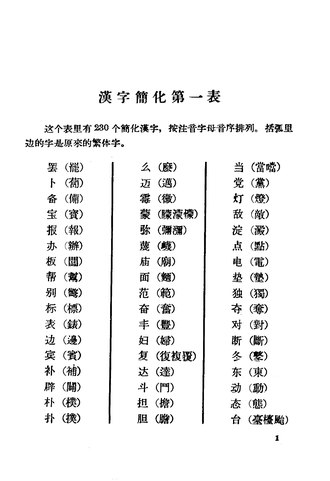Chinese Character Simplification Scheme
| Chinese Character Simplification Scheme | |||||||
|---|---|---|---|---|---|---|---|
 | |||||||
| Traditional Chinese | 漢字簡化方案 | ||||||
| Simplified Chinese | 汉字简化方案 | ||||||
| |||||||
The Chinese Character Simplification Scheme (simplified Chinese: 汉字简化方案; traditional Chinese: 漢字簡化方案; pinyin: Hànzì jiǎnhuà fāng'àn) is the standardised simplification of Chinese characters promulgated in the 1950s by the State Council of the People's Republic of China. It contains the existing Simplified Chinese characters that is in use today. To distinguish from the later Second round of simplified Chinese characters, this reform is also known as the First Chinese Character Simplification Scheme.
History
In 1952, the Language Reform Research Committee of China first drafted the List of Frequently Used Simplification of Chinese Characters, affirming to the principle of "only describing and stating the concept of the ancient people, not creating" (Chinese: 述而不作; pinyin: shù ér bù zuò).
The Chinese Character Simplification Scheme (Draft) was passed by the National Language Reform Meeting after discussion in October 1955, followed by modifications by the Language Reform Committee of China in accordance to the outcome of the discussions. The modified draft was reviewed by the State Council's Committee for the Application of the Chinese Character Simplification Scheme.
The 23rd State Council Plenary Meeting passed the Resolution Regarding the Promulgation of the "Chinese Character Simplification Scheme" on 28 January 1956.
On 31 January 1956, the People's Daily published in full about the Resolution Regarding the Promulgation of the "Chinese Character Simplification Scheme" and the Chinese Character Simplification Scheme. The first list of the scheme was used nationwide on 1 February 1956, and the rest was put into use in batches later.[1]
On 21 November 1955, more than two months earlier, the Ministry of Education issued a Notice Regarding the Implementation of Simplified Chinese Character in All Schools.[2] The People's Liberation Army General Political Department made similar notices in the same month.
Later development
Significant changes were subsequently made to this scheme, in particular the introduction of the principle of simplification by analogy. In May 1964, the Language Reform Committee published the List of Simplified Chinese Characters (simplified Chinese: 简化字总表; traditional Chinese: 簡化字總表; pinyin: Jiǎnhuà zì zǒng biǎo) to address the defects found in the Chinese Character Simplification Scheme.
It is divided into three parts. The first part records 352 simplified characters that are not used as radicals; The second part records simplified characters that may be used as radicals and 14 simplified radicals; The third part records 1,754 simplified characters that are formed according to its radicals. There are a total of 2,238 characters (realistically only 2,236 characters, as the characters 签 qiān and 须 xū appear twice as duplicates).
The Language Reform Committee of China proposed the Second Chinese Character Simplification Scheme (Draft) on 20 December 1977, rescinded in 1986.
In 1986, the National Language Working Committee published the amended List of Simplified Chinese Characters.
Structure
The Chinese Character Simplification Scheme is divided into three parts. The first part consists of 230 simplified characters; the second part consists of 285 simplified characters; the third part consists of 54 simplified radicals. The first and second parts differ in their time of implementation; the first part was to be implemented the day after the announcement, while the second part was mostly implemented in three batches later between 1956 and 1959 after further trials and slight changes, leaving out 28 simplified characters which were implemented in 1964 when the List of Simplified Chinese Characters was published.[1]
Controversy
The simplification of Chinese characters met strong resistance from the public and the academia. The prominent scholar Chen Mengjia was one of the outspoken critics of the scheme. When the Anti-Rightist Movement began in 1957, Chen was labeled a Rightist and attacked as an enemy of the Communist Party. In 1966, at the beginning of the Cultural Revolution, Chen was again severely persecuted for his ideas and committed suicide.[3]
See also
References
- ^ a b 国务院关于公布汉字简化方案的决议 (State Council's resolution regarding the promulgation of the Chinese Character Simplification Scheme)
- ^ "教育部關於在中学、小学、各級師範学校及工農業餘学校推行簡化漢字的通知" (PDF). 中華人民共和國國务院公報 (Gazette of the State Council of the People's Republic of China) (21): 1036–1037. 1955.
- ^ Hessler, Peter (2009). Oracle Bones: A Journey Through Time in China. HarperCollins. p. 386. ISBN 9780060826598.

